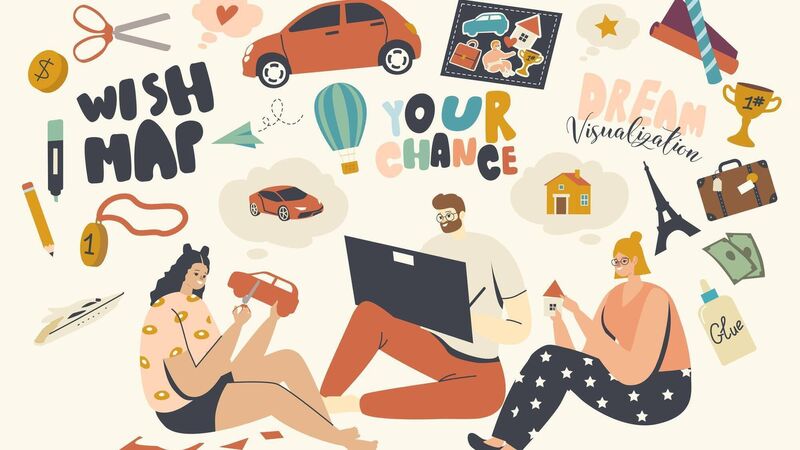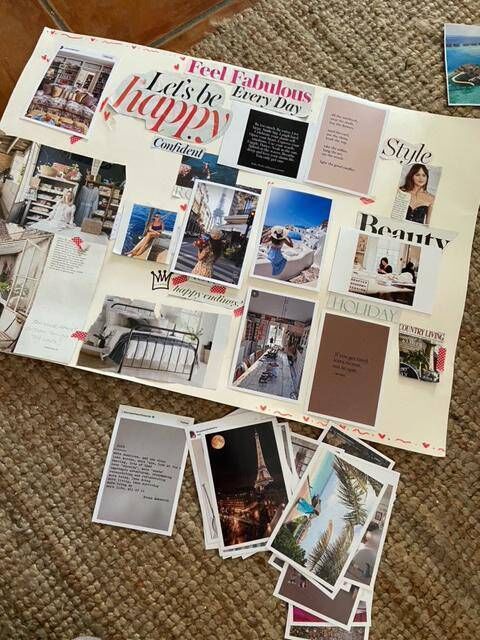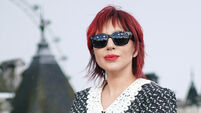What is a vision board - and can it really help you achieve your dreams?

Pic: iStock
January is that goal-setting, activity-planning time of year. And there are so many ways to plan the year ahead, from SMART goals to simply writing your goals for the year down in a notebook. This year, vision boards are having their moment. But what are they? And how do they work?
A vision board is a collection of images and words that represent your dreams or goals. Not to be confused with a mood board, which serves as more of an inspiration - if you’re redecorating your home for example. Vision boards are big with the celebrity set; stars like Reese Witherspoon, Katy Perry, Natalie Portman, and Oprah Winfrey swear by them, crediting them for their success.
“Vision boards are a visual interpretation of what you want, how you would like to feel, or where you want to go,” explains Michelle Fallon, who creates a new vision board at the start of every year.
Fallon is what you might call a vision board enthusiast. Many steps in her life have been goals or dreams she previously added to a vision board.
“Every year when I’m creating my vision board, I think about the things I want. A few years ago, when I was living in New York I made a vision board that planned my return to Ireland, living in a cottage, and running craft workshops. That’s exactly what I’m doing now.”
Fallon is quick to say that there’s no “woo woo magic” at play with vision boards. You’re simply imagining the life you want, and visualising it using the board.
The key with a vision board though is that you don’t just make it and leave it tucked away behind the sofa. You need to actively look at it, every day.
“Your vision board needs to be somewhere where you see it every day. You don’t necessarily have to do anything with your vision board, it’s enough that you are seeing it or looking at it. Some people will zero in on one or two aspects of their board and make a conscious effort to move closer to that goal, but there’s no pressure to do that,” says Fallon.

“Sure, there is a degree of manifestation about vision boards. However, neuroscience backs up the transformative power of visualisation. Information gained using brain scan imagining proves its impact on various cognitive processes and neural mechanisms,” explains trainer and career coach Elaine Fitzgerald McBarron.
“There are a lot of cool things happening here. Specifically in relation to visualisation; we see an increase in motivation and perseverance, potentially influencing the brain's reward and motivation systems. Also, using vision boards as a visualisation tool can strengthen the neural pathways associated with the imagined activities, leading to improved performance.”
Seeing your vision board every day reinforces your dreams and goals, and you’re more inclined to take steps towards achieving them. What’s more, you can also become that little bit more focused and more adept, at doing what’s needed to make your dreams a reality.
There are no rules with vision boards; they can look however you want them to look. Bright, colourful and sparkly? Great. Simple, clean and ordered? Great too. They are an extension of you in a way, designed to help you visualise your goals. You will be looking at this board every day so it needs to appeal to you.
Fallon advises clearing your physical space, and your head space before making a start. “I usually start with a 10 minute meditation to clear my mind so that I can focus completely on my vision board,” she says.
McBarron believes we tap into our subconscious during a vision board exercise. “The effect can be magnified when we use music and/or meditation to access a more relaxed and reflective state of mind. Imagine a calm pool of water, we can see more depth when the water is calm. So a calm mind, relaxing music, a quiet warm space, and burning incense can help to honour the process. But experiment too - a poppy tune, surrounded by friends in a fun, light-filled space might be much more your scene,” she says.
The idea is that you get yourself into a relaxed state of mind. You don’t want doubts, worries and stresses making their way into your process, or causing you to second guess what you want to add to your vision board. You’re focusing on what you want for the year, and imagining how you would like to feel. With your goals, you can decide to be quite general, or your can concentrate on something specific (organise your dream wedding for example). Write them down. They will form the basis of your vision board.

You’ll need a few bits and pieces to create your vision board, but be heartened, this is a low-cost project. First things first, you’ll need a board - this can be a large canvas (the kind you can pick up in a discount store, afterall, you’re not painting on this) or an A1 card; magazines, travel brochures, photos; pencils, pens, paints; scissors; and glue.
While vision boards typically focus on images, Fallon says it’s good to include some key words, affirmations, or inspirational quotes. Brainstorm words that sum up or relate to your dreams or goals, then go through your list to see if any words stand out. In the vision board workshops Fallon runs, common words tend to be love, travel, create, and home, for example.
You can choose to either write your words directly onto your vision board, or search for them in a magazine and cut them out.
You’ve got your list of goals, now grab some magazines and start looking for images. Fallon says you can approach this in two different ways: read through your list of goals and go through the magazines, choosing pictures that correspond to your goals; or flick through magazines until something jumps out at you. “Even if it’s not on your list I always encourage people to cut out what catches their eye, sometimes there’s a reason,” she says.
If you want to be precise with the images you add, you can search for images online, take a screenshot and then print them off using your own home printer, or use one of the many photo printing apps to get all your images printed.
Either way, you’ll need to cut out all your images and put them aside. “Don’t stick them down as you go. Wait until you have all your images before you commit to sticking them down. You want to be really sure about the images and intent,” says Fallon.
There’s a psychology behind vision boards, explains McBarron. “For visualisation and vision boards we need to move past a step by step, logical approach and access a more holistic, creative and emotional processing ability. These are all controlled by the right side of the brain. Vision boards allow us to tap into cognitive abilities such as spatial awareness, visual processing, seeing the 'bigger picture' and the connections between seemingly unrelated concepts.” Vision boards might sound like a simple craft project, but their potential shouldn’t be underestimated. There’s science and intent at play here that can drive you towards achieving your goals.







